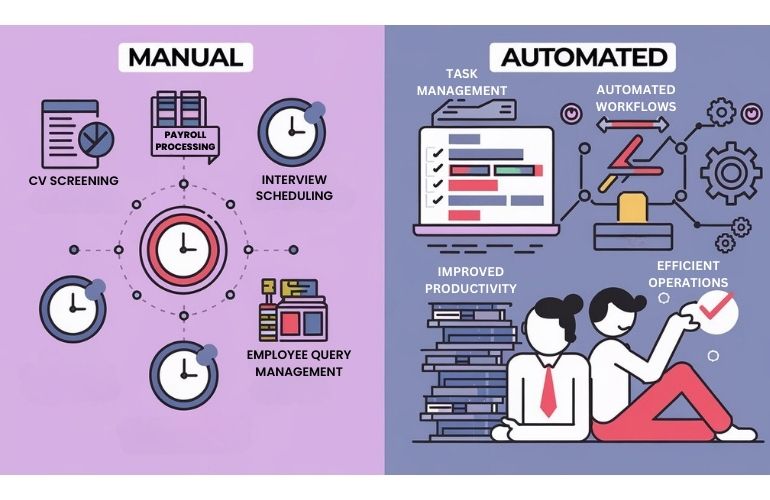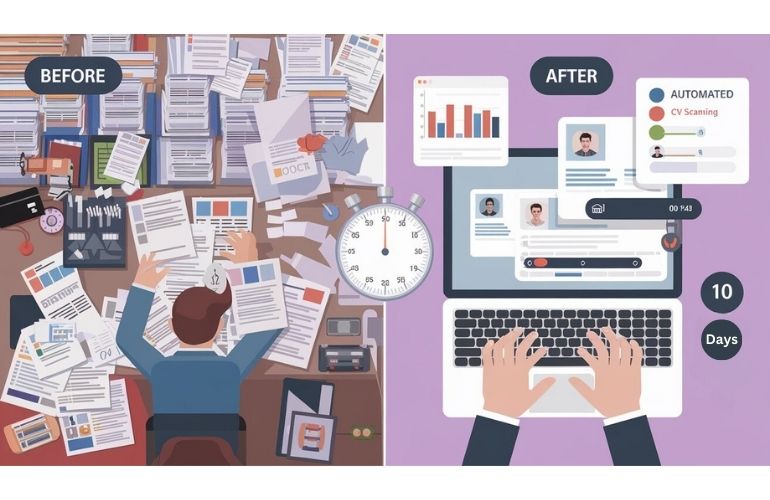Managing time efficiently is no longer just a personal goal but a professional necessity, especially in human resources (HR), in the hyper-paced work environment. The HR department, often burdened with the heavy lifting of recruitment, employee management, and compliance, is at the heart of organizational operations. However, juggling multiple responsibilities can often lead to overwhelming work pressure, a subject that has recently gained attention in India due to news reports on burnout, mental health struggles, and rising stress levels in the workplace.
This is where HR time management becomes crucial. By implementing smart, time-saving strategies, HR professionals can streamline their work, reduce pressure, and focus on higher-value tasks. In this blog, we’ll share practical HR tips for 2025 that will have you saying, “Why didn’t I think of that?”
Section 1: Automate the Mundane Tasks
Why Automation is Key
The first step toward mastering HR time management is to automate the repetitive, mundane tasks that consume a significant chunk of time daily. HR professionals often find themselves buried under routine tasks like scheduling interviews, tracking attendance, payroll processing, and responding to employee queries.
Tools to Use By leveraging HR automation tools, you can offload much of the administrative workload. Consider HR management systems (HRMS) that offer all-in-one solutions for recruitment, payroll, attendance management, and employee engagement. Tools like ConfluxHR, Zoho People and BambooHR are popular for automating these core functions, while AI-based recruitment platforms can even automate CV screening and initial interview scheduling.
Results
Implementing automation not only saves time but also reduces the chances of human error. According to a study by Gartner, companies that embraced automation in HR saw a 20% reduction in time spent on manual tasks and a 30% increase in operational accuracy.
Section 2: Streamline Recruitment with AI and Digital Solutions
The Time Drain of Traditional Recruitment
The recruitment process, especially when handled manually, is notorious for being time-consuming. Sorting through hundreds of CVs, conducting interviews, and onboarding new employees often takes weeks, if not months.

AI-Powered Solutions
This is where AI comes to the rescue. Tools like HireVue and Hiretual use AI to automate the initial stages of recruitment by scanning CVs, matching candidates to job requirements, and even conducting preliminary interviews via chatbots. With these digital solutions, HR professionals can focus on more strategic hiring decisions rather than getting bogged down by administrative work.
Bonus Tip
With AI-powered recruitment tools, HR time management becomes much more efficient. The recruitment process is accelerated, reducing hiring time by up to 50%, leading to quicker hires and a better match for open positions.
Section 3: Simplify Employee Onboarding
Why Onboarding Often Takes Too Much Time
Onboarding is a critical process but often ends up being a time-consuming endeavor for HR departments. From paperwork to training schedules, it’s easy to see why onboarding can turn into a significant drain on time and resources.
Digital Onboarding Platforms
To address this challenge, many organizations are turning to digital onboarding solutions. Platforms like ConfluxHR, WorkBright and Gusto offer self-service employee portals where new hires can upload their documents, complete training modules, and sign contracts digitally, reducing the HR team’s involvement in manual processes.
Case Study
Take Health & Wellness Corp, for example. By implementing digital onboarding, they reduced their onboarding time from two weeks to just three days, freeing up their HR team to focus on more strategic tasks like employee engagement and retention.
Section 4: Embrace a Paperless HR Department
The Hidden Cost of Paperwork
Managing paperwork and physical documents is a massive time sink for HR professionals. Filing, sorting, and retrieving documents not only takes time but also introduces the risk of errors or losing important files, which can lead to compliance issues.
Document Management Software
In 2025, going paperless is no longer just an option—it’s a necessity. Tools like ConfluxHR help HR teams manage compliance documents, contracts, and employee files digitally, ensuring easy access and better organization. These platforms also enable seamless collaboration with other departments and legal teams to ensure compliance without the hassle of manual filing.
Long-Term Benefits
By eliminating paperwork, HR departments can save hours spent on document management. The long-term benefits include increased compliance, reduced storage needs, and making documents more accessible from anywhere, especially with remote work being a continuing trend.
Section 5: Time-Blocking and Prioritization for HR Teams
Why HR Needs Time-Blocking
Time-blocking, a technique where you allocate specific periods for focused tasks, is a game-changer for HR time management. In a role where every day is filled with interruptions, setting aside time blocks for important tasks ensures that key priorities are addressed without distractions.
How to Implement
Implementing time-blocking in HR can be simple. Start by categorizing tasks into high-priority and low-priority activities. Use tools like Google Calendar or Asana to schedule these blocks. It’s important to stick to these time frames to ensure you’re not constantly shifting focus, which can significantly reduce productivity.
Results
A recent study showed that HR teams that adopted time-blocking improved their productivity by 35%, as the focused time allowed them to tackle high-impact tasks more efficiently, from recruitment to employee performance reviews.
Section 6: Outsource Non-Core Tasks
Why Outsourcing Works
Not every HR task needs to be handled internally. Functions like payroll processing, benefits management, and employee background checks can often be outsourced to external providers. This allows your HR team to focus on core functions like recruitment, employee engagement, and retention.
Best Practices
When outsourcing, it’s essential to find reliable partners. Tools like ADP and Paychex are popular for payroll outsourcing, while Sterling is a go-to for background checks. The key is to ensure the outsourced tasks integrate smoothly with your existing HRMS for a cohesive workflow.
HR Time Management Boost
By outsourcing non-core tasks, HR teams can save substantial time. This frees them up to focus on strategic initiatives that drive employee satisfaction and organizational growth. Additionally, outsourcing provides more scalability, allowing you to handle fluctuating workloads without overwhelming your internal team.
Conclusion
In 2025, HR time management is more critical than ever. With rising work pressures and time constraints, HR professionals must adopt smarter, more efficient ways to handle their workload. From automating mundane tasks and leveraging AI in recruitment to simplifying onboarding and embracing digital tools, these tips can significantly reduce time waste while boosting productivity.
Start implementing one of these tips today. Whether it’s automating your recruitment process or adopting a time-blocking approach, there’s no better time to rethink your HR strategy. Consider exploring HR tools like ConfluxHR or Zoho People to streamline your processes and make your team work smarter, not harder.




